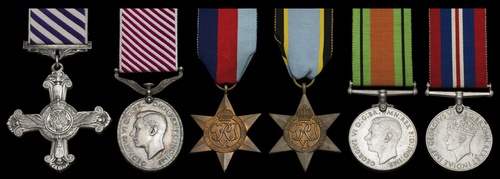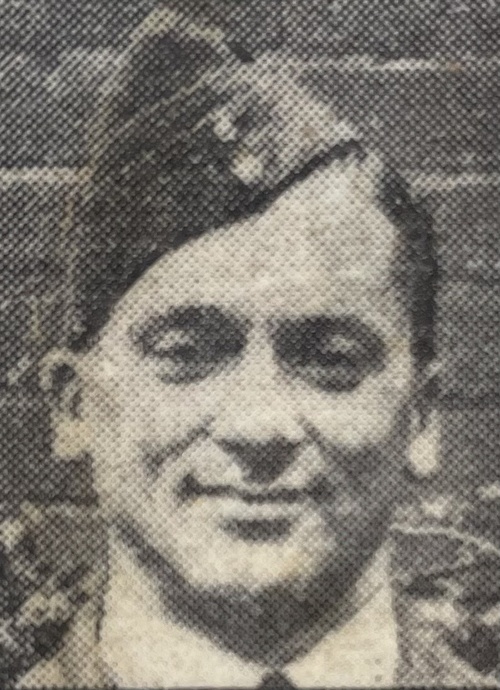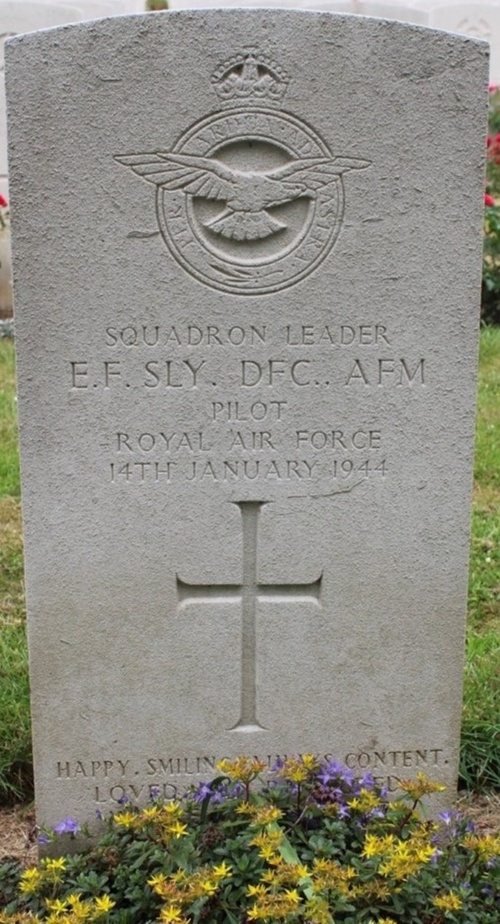Auction: 24003 - Orders, Decorations and Medals
Lot: 214
The extremely rare and poignant Second World War D.F.C., A.F.M. group of six awarded to Squadron Leader E. F. Sly, Royal Air Force
A highly skilled pilot, he was awarded the A.F.M. for saving the life of his pupil passenger when their aircraft suffered catastrophic damage in a mid-air collision in 1940: struck at an altitude of just 900 feet - with the resultant loss of half of his aircraft's starboard wing - he somehow managed to fly on for two miles before making make a miraculous wheels-up crash-landing
Subsequently commissioned, he completed an action-packed tour of operations as a Flight Commander in Stirlings of No. 218 (Gold Coast) Squadron in 1942-43, on one occasion being forced down to 300 feet on three engines by an enemy night fighter
Having then received rapid promotion to Acting Squadron Leader, he was killed in action in a strike by No. 514 Squadron on Brunswick in January 1944, when in yet another engagement with a night fighter, his Lancaster was shot down over Lower Saxony
Distinguished Flying Cross, G.VI.R., the reverse officially dated '1943'; Air Force Medal, G.VI.R. (566485 Sgt. E. F. Sly, R.A.F.); 1939-45 Star; Air Crew Europe Star; Defence and War Medals 1939-45, extremely fine (6)
There were just 12 D.F.C., A.F.M. combinations awarded to the Royal Air Force in the 1939-45 War, and only 15 in total for all Allied Air Forces.
D.F.C. London Gazette 14 May 1943. The original recommendation states:
'Squadron Leader Sly has been Flight Commander of 'B' Flight, No. 218 Squadron since December 1942 and has at all times shown outstanding ability.
In November 1942, while on an operation to Stuttgart, the starboard outer engine of his aircraft cut out in the target area. Despite this he pressed home his attack in a daring manner and made a safe return to base.
In January 1943, while on a gardening operation to the Baltic, his aircraft was attacked by enemy aircraft and hit in the port outer engine. The reduction gear fell off and although forced to come down to 300 feet, by superb airmanship and determination, Squadron Leader Sly made a safe return to base.
He has at all times displayed the highest degree of devotion to duty and determination of a high order, both factors being reflected by the splendid results of the crews in his Flight. He is very strongly recommended for the award of the Distinguished Flying Cross.'
A.F.M. London Gazette 11 October 1940. The original recommendation states:
'On 3 August 1940, Sergeant Sly was carrying out a formation flying practice in an Oxford aircraft with a pupil in another such aircraft. At an altitude of 900 feet he was warned by his passenger that the other aircraft was approaching from astern and was about to hit on the starboard side. Sergeant Sly immediately banked but was unable to avoid a collision and his starboard wing was practically severed just outboard of the engine. By exceptional coolness and skill he succeeded in making a forced landing with under-carriage retracted, without injury to himself or his passenger.'
Ernest Frank Sly was born in Bruton, Somerset on 16 September 1916 and joined the Royal Air Force in 1933. Having qualified for his 'Wings' he was serving as an N.C.O. flying instructor about the time of the outbreak of hostilities.
As cited above, he was subsequently awarded the A.F.M. for a stunning display of airmanship whilst serving at No. 3 Service Flying Training School in August 1940. In a related Air Ministry press release, it was reported that he regained control of his damaged Oxford trainer 'by using full-left aileron and full starboard engine - his right aileron having dropped off complete with the torn off wing.'
In his subsequent flight of two miles to find a landing ground, the Oxford's starboard wing continued to break up, but by 'exceptional coolness and skill' he managed a miraculous wheels-up crash-landing.
Bomber Command: 1st tour - No. 218 (Gold Coast) Squadron
Commissioned in August 1941 and advanced to Flying Officer in February 1942, Sly commenced an operational tour in No. 218 (Gold Coast) Squadron, a Stirling unit based at Downham Market, Norfolk, in August of the latter year.
Here, coincidentally, he likely visited 'Sly's Café' in the High Street, for it was a favourite haunt of the base's aircrew, especially after missing breakfast in the Mess on returning late from operations.
Having flown his sortie in September 1942 - against Dusseldorf - he notched up no less than eight operational outings in November, including two trips to Turin. But - as noted in the recommendation for his D.F.C. - it was during a strike against Stuttgart on the night of 22nd that his starboard outer engine cut out in the target area: despite this he pressed home his attack in a 'daring manner' and made a safe return to base.
The relevant O.R.B. entry states:
'Visibility good. Identification by river and railway marshalling yards. Fired at fighter on way in near target. Good fires seen 80 miles away. Returned on 3 engines.'
Having then undertaken a 'gardening' trip to the Kattegat - and attacked a target in Deipholz in December 1942 - Sly and his crew commenced the New Year with another 'gardening' trip to the Baltic on 8 January 1943, when, as noted in his D.F.C. recommendation, his Lancaster was 'attacked by enemy aircraft and hit in the port outer engine. The reduction gear fell off and although forced to come down to 300 feet, by superb airmanship and determination, Squadron Leader Sly made a safe return to base.'
Next assigned to Lorient on 23 January 1943, Sly reported with satisfaction that his bomb load 'exploded directly on the docks'.
He was advanced to Flight Lieutenant in February 1943, the same month in which he completed another six sorties, his targets including Cologne and Nuremburg, in addition to the docks at St. Nazaire. And by the time of being recommended for the D.F.C. in mid-March, he had completed further sorties to Essen, Munich and Stuttgart.
In the following month, the squadron was assigned to further 'gardening' operations, one such - on 28 April - proving eventful. That evening, eight crews - including Sly's - took off for the 'Sweet Peas' target area along the Helsinki-Malmo shipping lanes. All appeared to be in order until Sly crossed the Danish coast at 7,000 feet on the return leg, when - without any warning from his two gunners - his Stirling was attacked by a night fighter, tracer fire passing just feet above the port wing from the port beam high. Sly put BK687 HA-R 'Robert' into a steep dive towards the safety of the clouds less than 500 feet below. It was a close shave.
And so, the sorties continued, including further trips to the Ruhr, up until early June 1943, when Sly - tour expired - was 'rested'.
Journey's end: 2nd tour - No. 514 Squadron
In November 1943, after attending a conversion unit, he was posted to No. 514 Squadron, a Lancaster unit operating out of Waterbeach, Cambridgeshire. Having flown three sorties in the interim, he and his crew were ordered to attack Brunswick on the night of 14-15 January 1944, the first major raid on the town of the war.
German defences tracked the bomber stream from just off the English coastline and many enemy night fighters entered the stream over Bremen, continuing to score hits until the stream left the Dutch coast on the return leg: losses were very high, 38 Lancasters being downed - or 7.6% of the attacking force. Among them was Sly's Lancaster II LL685, which was shot down by Hauptman Walter Barte of Stab III/NJG3 near Bennebostel, Germany.
In March 1946, in an interview conducted by the War Graves Commission, an ex-German Police Chief - Otto Kruge - revealed the final fate of Sly and his crew:
'One more British aircraft crashed on 14 January 1944, at about 1930 hours in the parish of Westercelle on the estate of Herr Hoeper, a schoolteacher in Bennebostel. Six dead crew were recovered. All the corpses were buried in a communal grave … The Fliegerhorst (airfield) ordered the decent burial of this crew.'
Those remains were subsequently re-interred in Hanover War Cemetery. Ernest was the son of Frank William and Florence Mary Sly, of Bruton, Somerset, who chose the following epitaph for his headstone:
'Happy, Smiling, Always Content, Loved and Respected Wherever He Went.'
He was 27; sold with an original Air Ministry press photograph of his much-damaged Oxford trainer, together with a related newspaper cutting.
Subject to 20% VAT on Buyer’s Premium. For more information please view Terms and Conditions for Buyers.
Sold for
£5,200
Starting price
£2300











